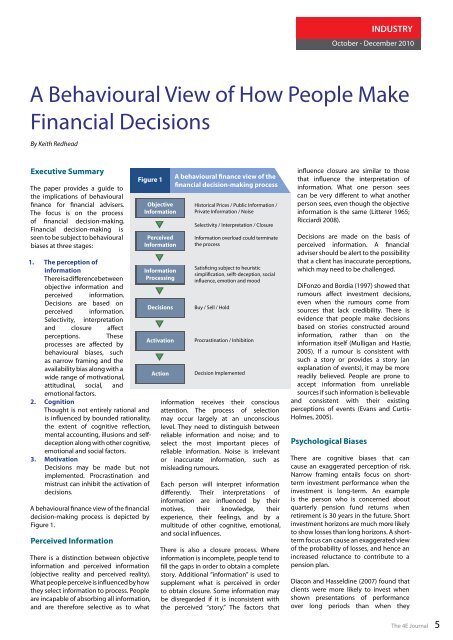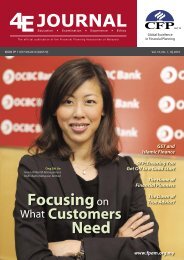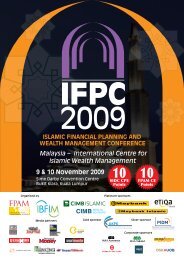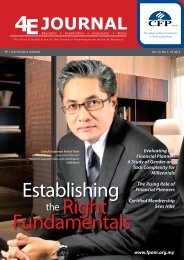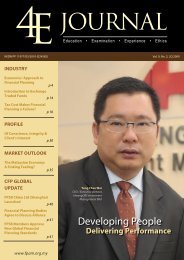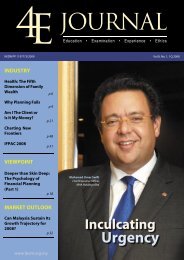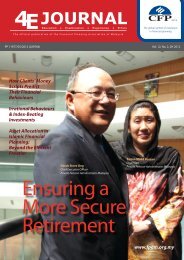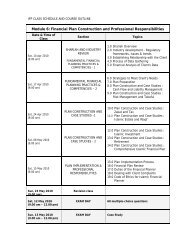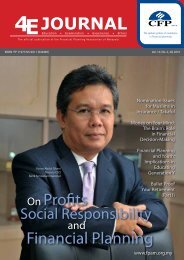Vol 10, No 4 - Financial Planning Association of Malaysia
Vol 10, No 4 - Financial Planning Association of Malaysia
Vol 10, No 4 - Financial Planning Association of Malaysia
You also want an ePaper? Increase the reach of your titles
YUMPU automatically turns print PDFs into web optimized ePapers that Google loves.
INDUSTRY<br />
October - December 20<strong>10</strong><br />
A Behavioural View <strong>of</strong> How People Make<br />
<strong>Financial</strong> Decisions<br />
By Keith Redhead<br />
Executive Summary<br />
The paper provides a guide to<br />
the implications <strong>of</strong> behavioural<br />
finance for financial advisers.<br />
The focus is on the process<br />
<strong>of</strong> financial decision-making.<br />
<strong>Financial</strong> decision-making is<br />
seen to be subject to behavioural<br />
biases at three stages:<br />
1. The perception <strong>of</strong><br />
information<br />
There is a difference between<br />
objective information and<br />
perceived information.<br />
Decisions are based on<br />
perceived information.<br />
Selectivity, interpretation<br />
and closure affect<br />
perceptions. These<br />
processes are affected by<br />
behavioural biases, such<br />
as narrow framing and the<br />
availability bias along with a<br />
wide range <strong>of</strong> motivational,<br />
attitudinal, social, and<br />
emotional factors.<br />
2. Cognition<br />
Thought is not entirely rational and<br />
is influenced by bounded rationality,<br />
the extent <strong>of</strong> cognitive reflection,<br />
mental accounting, illusions and selfdeception<br />
along with other cognitive,<br />
emotional and social factors.<br />
3. Motivation<br />
Decisions may be made but not<br />
implemented. Procrastination and<br />
mistrust can inhibit the activation <strong>of</strong><br />
decisions.<br />
A behavioural finance view <strong>of</strong> the financial<br />
decision-making process is depicted by<br />
Figure 1.<br />
Perceived Information<br />
Figure 1<br />
There is a distinction between objective<br />
information and perceived information<br />
(objective reality and perceived reality).<br />
What people perceive is influenced by how<br />
they select information to process. People<br />
are incapable <strong>of</strong> absorbing all information,<br />
and are therefore selective as to what<br />
Objective<br />
Information<br />
Perceived<br />
Information<br />
Information<br />
Processing<br />
Decisions<br />
Activation<br />
Action<br />
A behavioural finance view <strong>of</strong> the<br />
financial decision-making process<br />
Historical Prices / Public Information /<br />
Private Information / <strong>No</strong>ise<br />
Selectivity / Interpretation / Closure<br />
Information overload could terminate<br />
the process<br />
Satisficing subject to heuristic<br />
simplification, selft-deception, social<br />
influence, emotion and mood<br />
Buy / Sell / Hold<br />
Procrastination / Inhibition<br />
Decision Implemented<br />
information receives their conscious<br />
attention. The process <strong>of</strong> selection<br />
may occur largely at an unconscious<br />
level. They need to distinguish between<br />
reliable information and noise; and to<br />
select the most important pieces <strong>of</strong><br />
reliable information. <strong>No</strong>ise is irrelevant<br />
or inaccurate information, such as<br />
misleading rumours.<br />
Each person will interpret information<br />
differently. Their interpretations <strong>of</strong><br />
information are influenced by their<br />
motives, their knowledge, their<br />
experience, their feelings, and by a<br />
multitude <strong>of</strong> other cognitive, emotional,<br />
and social influences.<br />
There is also a closure process. Where<br />
information is incomplete, people tend to<br />
fill the gaps in order to obtain a complete<br />
story. Additional “information” is used to<br />
supplement what is perceived in order<br />
to obtain closure. Some information may<br />
be disregarded if it is inconsistent with<br />
the perceived “story.” The factors that<br />
influence closure are similar to those<br />
that influence the interpretation <strong>of</strong><br />
information. What one person sees<br />
can be very different to what another<br />
person sees, even though the objective<br />
information is the same (Litterer 1965;<br />
Ricciardi 2008).<br />
Decisions are made on the basis <strong>of</strong><br />
perceived information. A financial<br />
adviser should be alert to the possibility<br />
that a client has inaccurate perceptions,<br />
which may need to be challenged.<br />
DiFonzo and Bordia (1997) showed that<br />
rumours affect investment decisions,<br />
even when the rumours come from<br />
sources that lack credibility. There is<br />
evidence that people make decisions<br />
based on stories constructed around<br />
information, rather than on the<br />
information itself (Mulligan and Hastie,<br />
2005). If a rumour is consistent with<br />
such a story or provides a story (an<br />
explanation <strong>of</strong> events), it may be more<br />
readily believed. People are prone to<br />
accept information from unreliable<br />
sources if such information is believable<br />
and consistent with their existing<br />
perceptions <strong>of</strong> events (Evans and Curtis-<br />
Holmes, 2005).<br />
Psychological Biases<br />
There are cognitive biases that can<br />
cause an exaggerated perception <strong>of</strong> risk.<br />
Narrow framing entails focus on shortterm<br />
investment performance when the<br />
investment is long-term. An example<br />
is the person who is concerned about<br />
quarterly pension fund returns when<br />
retirement is 30 years in the future. Short<br />
investment horizons are much more likely<br />
to show losses than long horizons. A shortterm<br />
focus can cause an exaggerated view<br />
<strong>of</strong> the probability <strong>of</strong> losses, and hence an<br />
increased reluctance to contribute to a<br />
pension plan.<br />
Diacon and Hasseldine (2007) found that<br />
clients were more likely to invest when<br />
shown presentations <strong>of</strong> performance<br />
over long periods than when they<br />
The 4E Journal 5


